|
|
#1021 |
|
⊙▃⊙
|
Daily Suspicious0bserver's Weather Post:
August 14, 2014 What's in the sky tonight? August 14, 2014 -Vega is almost overhead after dark. The brightest star in the southeast is Altair, nearly as bright. Altair is flagged by little Tarazed (3rd magnitude) a finger-width above it: an orange giant far in Altair's background. -Observers reporting to the International Meteor Organization say that Perseid meteor rates are still high, greater than 40 per hour on Aug. 13-14. This means Earth has not yet exited the debris stream of parent comet Swift-Tuttle. If it is dark where you live, go outside and look up. -Before the Perseid meteor shower began, forecasters worried that people might not see it due to the glare of a supermoon. This photo illustrates why the Perseids succeeded in spite of lunar interference; the shower is rich in fireballs. "This was the brightest Perseid I saw on the night of August 12/13," says photographer Pete Lawrence. "Visually, it was a stunner!" After the meteor exploded over Lawrence's home in Selsey, UK, a wispy trail of debris appeared where the meteor had been a split-second before. "I recorded it in the very next frame," he says. This is "meteor smoke," a sinuous cloud of microscopic cinders tracing the path of the incinerating fireball. The particles of meteor smoke disperse in Earth's upper atmosphere and, ultimately, become the seeds of noctilucent clouds. All meteors produce such smoke, but only the brightest fireballs create a lingering trail bright enough to see with the unaided eye. Light from the supermoon, ironically, helps us see meteor smoke, because reflected moonlight increases the visibility of smoky debris. As a result, the smoke may have been photographed more often than usual during the 2014 Perseids. -Every night, a network of NASA all-sky cameras scans the skies above the United States for meteoritic fireballs. Automated software maintained by NASA's Meteoroid Environment Office calculates their orbits, velocity, penetration depth in Earth's atmosphere and many other characteristics. On Aug. 13, 2014, the network reported 163 fireballs. (99 Perseids, 61 sporadics, 1 Northern Delta Aquarid, 1 Southern Delta Aquarid, 1 Southern Iota Aquarid) 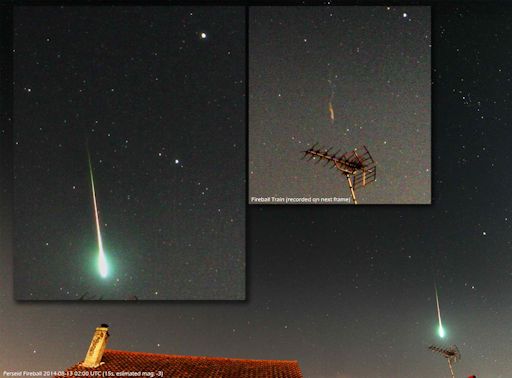 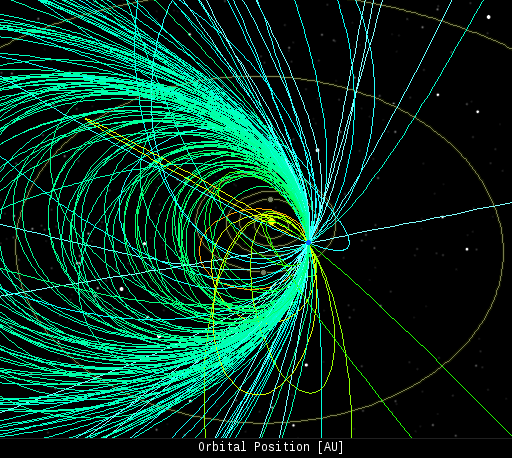 Astro Picture of the Day: August 14, 2014 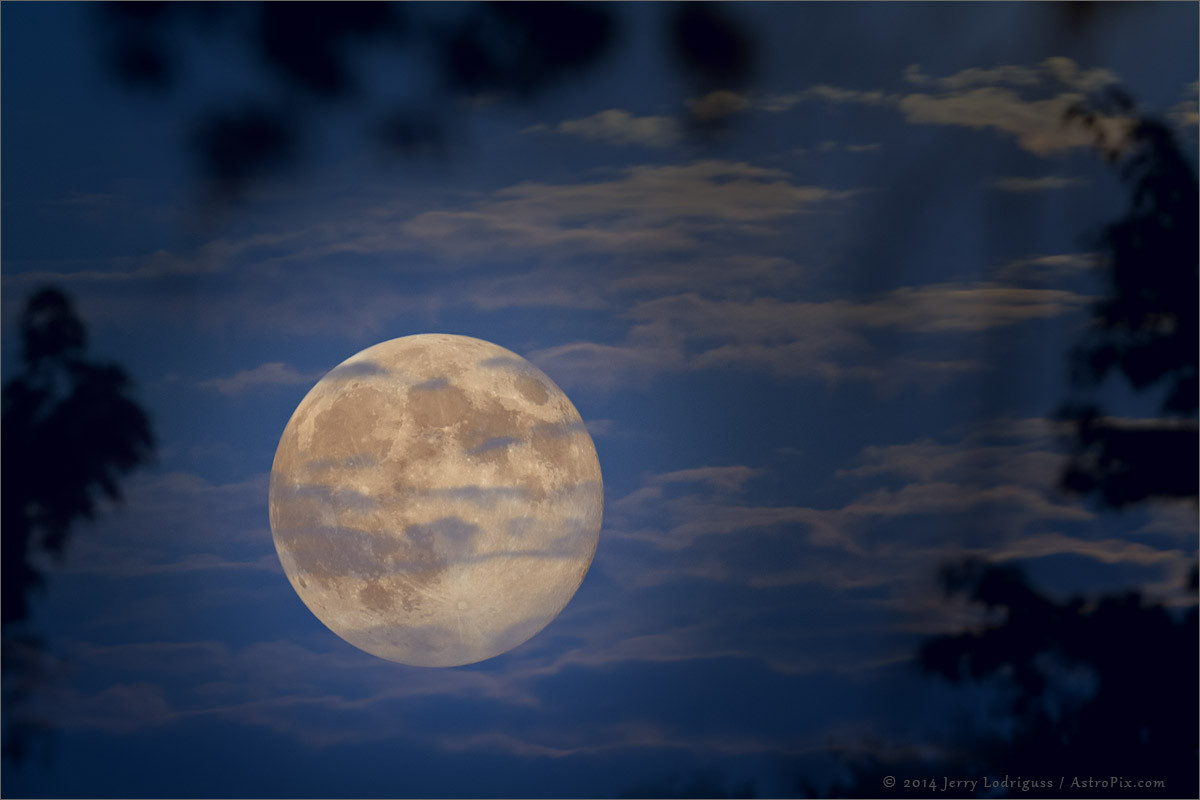 Big, bright, and beautiful, a Full Moon near perigee, the closest point in its elliptical orbit around our fair planet, rose on August 10. This remarkable picture records the scene with a dreamlike quality from the east coast of the United States. The picture is actually a composite of 10 digital frames made with exposures from 1/500th second to 1 second long, preserving contrast and detail over a much wider than normal range of brightness. At a perigee distance of a mere 356,896 kilometers, August's Full Moon was the closest, and so the largest and most super, of the three Full Moons nearest perigee in 2014 now popularly known as supermoons. But if you missed August's super supermoon, the next not-quite-so supermoon will be September 8. Then, near the full lunar phase the Moon's perigee will be a slightly more distant 358,387 kilometers. That's only about 0.4 percent less super (farther and smaller) than the super supermoon.
__________________
1st in Kommisar's 2009 SM Tournament 1st in I Love You`s 2009 New Year`s Tournament 3rd in EnR's Mashfest '08 tournament 5th in Phynx's Unofficial FFR Tournament 9th in D3 of the 2008-2009 4th Official FFR Tournament 10th in D5 of the 2010 5th Official FFR Tournament 10th in D6 of the 2011-2012 6th Official FFR Tournament FMO AAA Count: 71 FGO AAA Count: 10 Bluearrowll = The Canadian player who can not detect awkward patterns. If it's awkward for most people, it's normal for Terry. If the file is difficult but super straight forward, he has issues. If he's AAAing a FGO but then heard that his favorite Hockey team was losing by a point, Hockey > FFR PS: Cool AAA's Terry - I Love You An Alarm Clock's Haiku beep beep beep beep beep beep beep beep beep beep beep beep beep beep beep beep beep - ieatyourlvllol |
|
|

|
|
|
#1022 |
|
⊙▃⊙
|
Daily Suspicious0bserver's Weather Post:
August 15, 2014 What's in the sky tonight? August 15, 2014 -For the next several mornings, look low in the east-northeast about 45 to 30 minutes before sunrise for Venus and Jupiter very close together. On Saturday morning, these two brightest planets are still 2░ apart, as shown at right. They'll be closest on Monday morning the 18th: just 0.2░ or 0.25░ apart at the time of dawn for Europe, 0.3░ by the time dawn reaches the Americas. -Solar activity has been low for more than month, and there are scant signs of change in the offing. Not one of the sunspots now crossing the solar disk poses a threat for strong eruptions. As a result, NOAA forecasters put the odds of an M- or X-class solar flare during the next 24 hours at no more than 1%. -On August 6th, Europe's Rosetta spacecraft rendezvoused with Comet 67P/Churyumov-Gerasimenko and began to fly alongside it. Seven days later, mission scientists released this spectacular view of the comet's double-lobed core. A closer look reveals many interesting features: While the comet's head (in the top half of the image) is scored with parallel linear features, the neck is peppered with boulders resting on a smooth underlying terrain. In comparison, the comet's body (lower half of the image) is jagged and dimpled by crater-like depressions. Now imagine this magnificent landscape ruptured by dozens of geysers spewing dust and gas into space. Future pictures may show exactly that. Rosetta will follow this comet for more than a year as it approaches the sun. In 2015, if not sooner, solar heating will activate the comet's icy core, creating a riot of activity the likes of which no spacecraft has ever seen before. Stay tuned for that. Full Res Image: http://www.esa.int/var/esa/storage/i...7_August_a.jpg  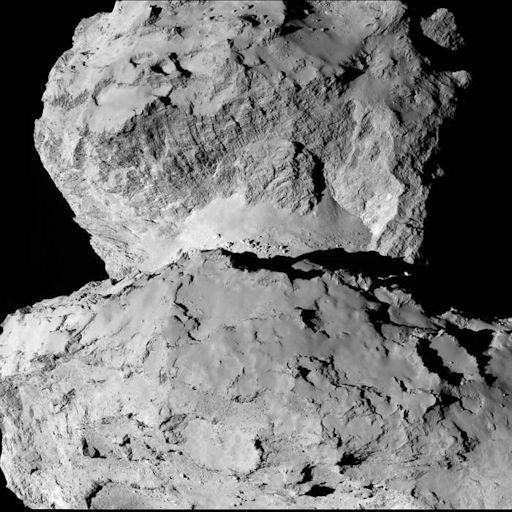 Astro Picture of the Day: August 15, 2014  Bright moonlight from a Full Moon near perigee illuminates the night and casts shadows in this skyscape from central Iran. Taken on August 12, near the peak of the annual Perseid meteor shower the exposure also captures a bright and colorful perseid streak above the shady tree in the foreground. This year the super moonlight interfered with meteor watching into the early morning hours, overwhelming the trails from many fainter perseids in the shower. Brighter perseids like this one were still visible though, their trails pointing back to the heroic constellation Perseus outlined at the right. Swept up as planet Earth orbits through dust left behind from periodic comet Swift-Tuttle, the cosmic grains that produce perseid meteors enter the atmosphere at nearly 60 kilometers per second, heated to incandesence and vaporized at altitudes of about 100 kilometers. Next year, Perseid meteors will flash through dark skies under a New Moon.
__________________
1st in Kommisar's 2009 SM Tournament 1st in I Love You`s 2009 New Year`s Tournament 3rd in EnR's Mashfest '08 tournament 5th in Phynx's Unofficial FFR Tournament 9th in D3 of the 2008-2009 4th Official FFR Tournament 10th in D5 of the 2010 5th Official FFR Tournament 10th in D6 of the 2011-2012 6th Official FFR Tournament FMO AAA Count: 71 FGO AAA Count: 10 Bluearrowll = The Canadian player who can not detect awkward patterns. If it's awkward for most people, it's normal for Terry. If the file is difficult but super straight forward, he has issues. If he's AAAing a FGO but then heard that his favorite Hockey team was losing by a point, Hockey > FFR PS: Cool AAA's Terry - I Love You An Alarm Clock's Haiku beep beep beep beep beep beep beep beep beep beep beep beep beep beep beep beep beep - ieatyourlvllol |
|
|

|
|
|
#1023 |
|
⊙▃⊙
|
Daily Suspicious0bserver's Weather Post:
August 16, 2014 What's in the sky tonight? August 16, 2014 -The two brightest stars of summer are Vega, overhead right after dark, and Arcturus, shining in the west. Vega is a white-hot type-A star 25 light-years away. Arcturus is an orange-yellow-hot type-K giant 37 light-years distant. Their color difference is fairly clear to the unaided eye. Both are dozens of times more luminous than the Sun. -Set your alarm for dawn! Venus and Jupiter are converging for a spectacular conjunction in the early morning sky. Closest approach: August 18th. Video: https://www.youtube.com/watch?v=yK57BMj2Vj4 Astro Picture of the Day: August 16, 2014 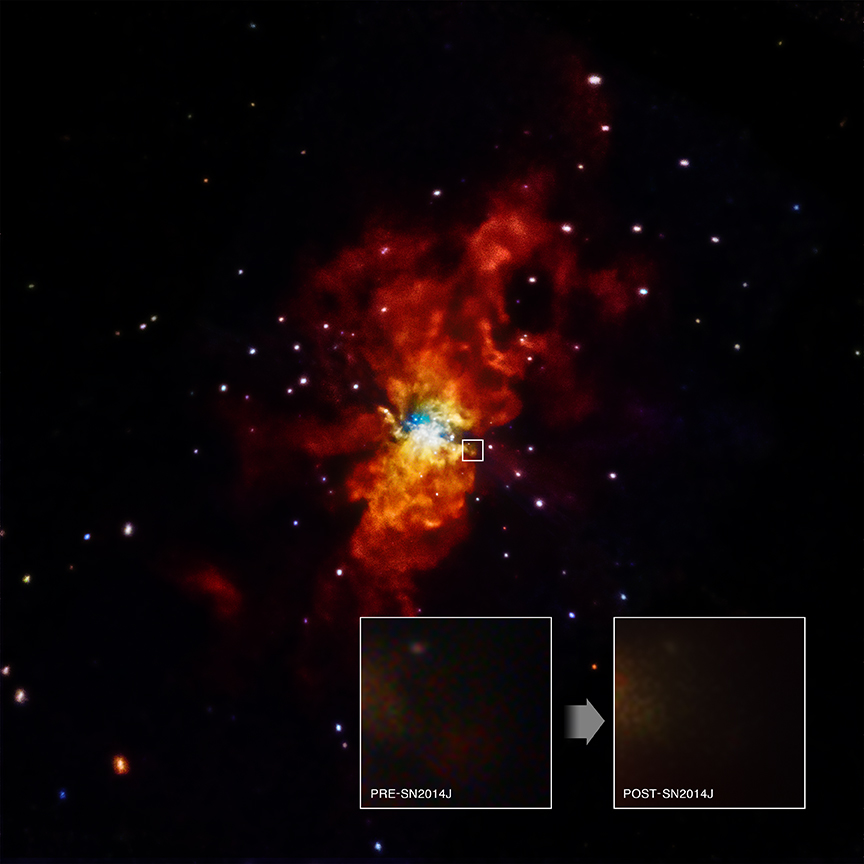 Last January, telescopes in observatories around planet Earth were eagerly used to watch the rise of SN 2014J, a bright supernova in nearby galaxy M82. Still, the most important observations may have been from orbit where the Chandra X-ray Observatory saw nothing. Identified as a Type Ia supernova, the explosion of SN2014J was thought to be triggered by the buildup of mass on a white dwarf star steadily accreting material from a companion star. That model predicts X-rays would be generated when the supernova blastwave struck the material left surrounding the white dwarf. But no X-rays were seen from the supernova. The mostly blank close-ups centered on the supernova's position are shown in the before and after inset panels of Chandra's false color X-ray image of the M82 galaxy. The stunning lack of X-rays from SN 2014J will require astronomers to explore other models to explain what triggers these cosmic explosions.
__________________
1st in Kommisar's 2009 SM Tournament 1st in I Love You`s 2009 New Year`s Tournament 3rd in EnR's Mashfest '08 tournament 5th in Phynx's Unofficial FFR Tournament 9th in D3 of the 2008-2009 4th Official FFR Tournament 10th in D5 of the 2010 5th Official FFR Tournament 10th in D6 of the 2011-2012 6th Official FFR Tournament FMO AAA Count: 71 FGO AAA Count: 10 Bluearrowll = The Canadian player who can not detect awkward patterns. If it's awkward for most people, it's normal for Terry. If the file is difficult but super straight forward, he has issues. If he's AAAing a FGO but then heard that his favorite Hockey team was losing by a point, Hockey > FFR PS: Cool AAA's Terry - I Love You An Alarm Clock's Haiku beep beep beep beep beep beep beep beep beep beep beep beep beep beep beep beep beep - ieatyourlvllol |
|
|

|
|
|
#1024 |
|
⊙▃⊙
|
Daily Suspicious0bserver's Weather Post:
August 17, 2014 What's in the sky tonight? August 17, 2014 -As dawn brightens on Monday morning, look for Jupiter and Venus having their very close conjunction low in the east-northeast, 0.2░ or 0.3░ apart, as shown below. The best view should be about 60 to 30 minutes before your local sunrise time. -The Moon is at last quarter (exact at 8:26 a.m. on the 17th EDT). It shines high in the southeast in early dawn on this date, with the Pleiades roughly a fist-width at arm's length to its left and a bit higher.  Astro Picture of the Day: August 17, 2014  It was visible around the world. The sunset conjunction of Jupiter and Venus in 2012 was visible almost no matter where you lived on Earth. Anyone on the planet with a clear western horizon at sunset could see them. Pictured above in 2012, a creative photographer traveled away from the town lights of Szubin, Poland to image a near closest approach of the two planets. The bright planets were separated only by three degrees and his daughter struck a humorous pose. A faint red sunset still glowed in the background. Early tomorrow (Monday) morning, the two planets will pass even closer -- only 0.2 degrees apart as visible from some locations -- just before sunrise.
__________________
1st in Kommisar's 2009 SM Tournament 1st in I Love You`s 2009 New Year`s Tournament 3rd in EnR's Mashfest '08 tournament 5th in Phynx's Unofficial FFR Tournament 9th in D3 of the 2008-2009 4th Official FFR Tournament 10th in D5 of the 2010 5th Official FFR Tournament 10th in D6 of the 2011-2012 6th Official FFR Tournament FMO AAA Count: 71 FGO AAA Count: 10 Bluearrowll = The Canadian player who can not detect awkward patterns. If it's awkward for most people, it's normal for Terry. If the file is difficult but super straight forward, he has issues. If he's AAAing a FGO but then heard that his favorite Hockey team was losing by a point, Hockey > FFR PS: Cool AAA's Terry - I Love You An Alarm Clock's Haiku beep beep beep beep beep beep beep beep beep beep beep beep beep beep beep beep beep - ieatyourlvllol |
|
|

|
|
|
#1025 |
|
⊙▃⊙
|
Daily Suspicious0bserver's Weather Post:
August 18, 2014 What's in the sky tonight? August 18, 2014 -Look northeast as soon as the stars come out for W-shaped Cassiopeia. In twilight it's not quite as high as the Big Dipper is in the northwest, but right after dark, Cassiopeia and the Dipper reach their balance point. Summer is nearing its end. -NOAA forecasters estimate a 30% chance of polar geomagnetic storms on August 18th when a faint CME is expected to strike Earth's magnetic field head-on. This is not a major event. Nevertheless, high-latitude sky watchers should be alert for auroras when the CME arrives. -This morning Venus and Jupiter converged in the pre-dawn sky for a spectacular conjunction. At closest aproach they were barely 0.2o apart. Didier Van Hellemont sends this picture from Les Estables, France. "I photographed Venus and Jupiter from Mount Mezenc, one of the higher points of the Auvergne region in France," says Van Hellemont. "The sky was so clear and beautiful. It was definitely worth the early wake-up call." The planets are separating now, but not too quickly. They will still be a beautiful pair for the rest of the week. A date of special interest is August 23rd when the crescent Moon joins the planets to form a bright celestial triangle in the eastern pre-dawn sky. Observing tips: Go outside 30 minutes before sunrise and look north-northeast. No telescope is required. Jupiter and Venus are bright enough to see with the naked eye even from light polluted cities. Try following the bright pair after the dawn sky begins to brighten. A tight conjunction of Venus and Jupiter framed by twilight blue is a great way to start the day. 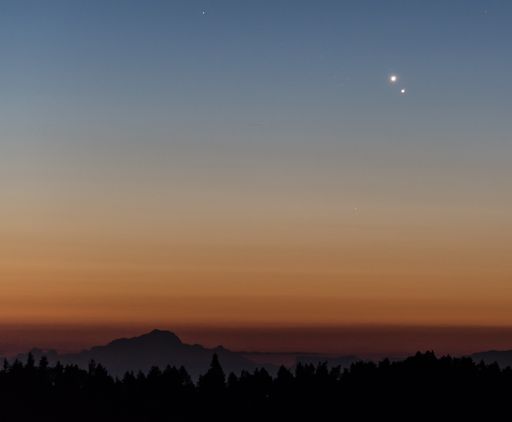 Astro Picture of the Day: August 18, 2014 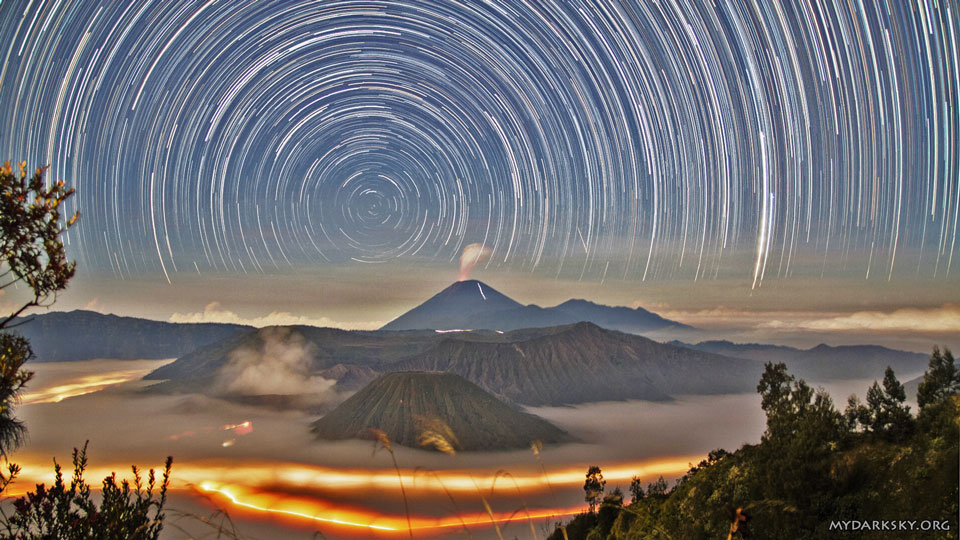 Both land and sky were restless. The unsettled land included erupting Mount Semeru in the distance, the caldera of steaming Mount Bromo on the left, flowing fog, and the lights of moving cars along roads that thread between hills and volcanoes in Bromo Tengger Semeru National Park in East Java, Indonesia. The stirring sky included stars circling the South Celestial Pole and a meteor streaking across the image right. The above 270-image composite was taken from King Kong Hill in mid-June over two hours, with a rising Moon lighting the landscape. My images of the Venus - Jupiter conjunction from this morning:   
__________________
1st in Kommisar's 2009 SM Tournament 1st in I Love You`s 2009 New Year`s Tournament 3rd in EnR's Mashfest '08 tournament 5th in Phynx's Unofficial FFR Tournament 9th in D3 of the 2008-2009 4th Official FFR Tournament 10th in D5 of the 2010 5th Official FFR Tournament 10th in D6 of the 2011-2012 6th Official FFR Tournament FMO AAA Count: 71 FGO AAA Count: 10 Bluearrowll = The Canadian player who can not detect awkward patterns. If it's awkward for most people, it's normal for Terry. If the file is difficult but super straight forward, he has issues. If he's AAAing a FGO but then heard that his favorite Hockey team was losing by a point, Hockey > FFR PS: Cool AAA's Terry - I Love You An Alarm Clock's Haiku beep beep beep beep beep beep beep beep beep beep beep beep beep beep beep beep beep - ieatyourlvllol |
|
|

|
|
|
#1026 |
|
⊙▃⊙
|
Daily Suspicious0bserver's Weather Post:
August 19, 2014 What's in the sky tonight? August 19, 2014 -If you're in the Earth's mid-northern latitudes, bright Vega passes close by your zenith just as night becomes fully dark. Whenever you see Vega at its closest to straight up, you know that Sagittarius, with its deep-sky riches, is at its highest in the south. -A minor CME hit Earth's magnetic field on August 19th at approximately 06:30 UT. The impact was not a strong one. Nevertheless, mild to moderate geomagnetic storms are possible at high latitudes as Earth moves through the CME's wake on August 19-20. -Set your alarm for dawn. Venus and Jupiter are putting on a fantastic show in the early morning sky. At daybreak on Tuesday, August 19, Marek Nikodem caught the planets rising over Szubin, Poland: "It was a beautiful celestial dawn," says Nikodem, "definitely worth waking up for." Following their 0.2o near-miss on Monday, August 18th, Venus and Jupiter are separating, but not too quickly. They'll remain in the same patch of sunrise sky for the rest of the week. A date of special interest is August 23rd when the crescent Moon joins the planets to form a must-see celestial triangle. 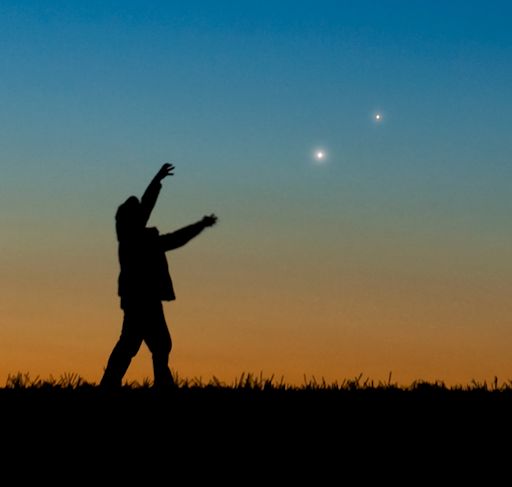 Astro Picture of the Day: August 19, 2014  Where should Philae land? As ESA's robotic spacecraft Rosetta circles toward Comet 67P/ Churyumov-Gerasimenko, a decision must eventually be made as to where its mechanical lander should attempt to touch-down. Reaching the comet earlier this month, Rosetta is sending back detailed pictures of the comet's unusual nucleus from which a smooth landing site will be selected. Pictured above, near the image top, the head of the comet's nucleus shows rugged grooves, while near the image bottom, the body shows a patch-work of areas sometimes separated by jagged hills. Some of the patch-work areas apparent on both the head and body seem to have fields of relatively smooth terrain. In the connecting area called the neck, however, visible across the image center, a relatively large swath of light-colored smooth terrain appears, punctuated occasionally by large boulders. Rosetta is scheduled to release Philae toward the dark mountain-sized comet nucleus with an anticipated landing date in November. Daily Suspicious0bserver's Weather Post: August 20, 2014 What's in the sky tonight? August 20, 2014 -A moderate (G2-class) geomagnetic storm that erupted following a CME strike on August 19th is subsiding now. At its peak, the storm sparked auroras around both poles visible from the ground and from space. Astronaut Reid Wiseman took this picture from the window of the International Space Station: "Never in my wildest dreams did I imagine this," tweeted Wiseman (@astro_reid). "Unbelievable." Around the Arctic Circle where the midnight sun has overwhelmed auroras since Spring, observers caught their first glimpse of Northern Lights in months "At one point a massive corona unfolded just over my head!" reports Alexander Kuznetsov from the Finnish Lapland. "It was a great season opener," added Pekka Hyytinen of Tampere, Finland. "I also caught a lightning strike in one of my photos." Solar wind conditions are unsettled but calming as Earth passes through the wake of the CME. NOAA forecasters estimate a waning 30% to 15% chance of more geomagnetic storms during the next 24 hours. 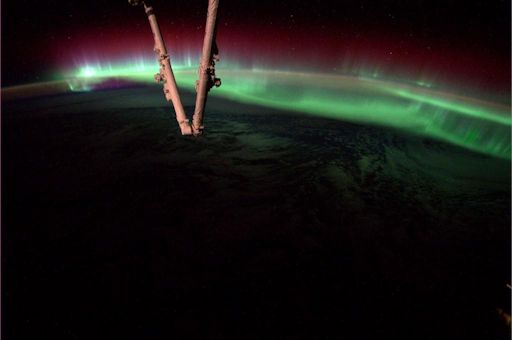 Astro Picture of the Day: August 20, 2014 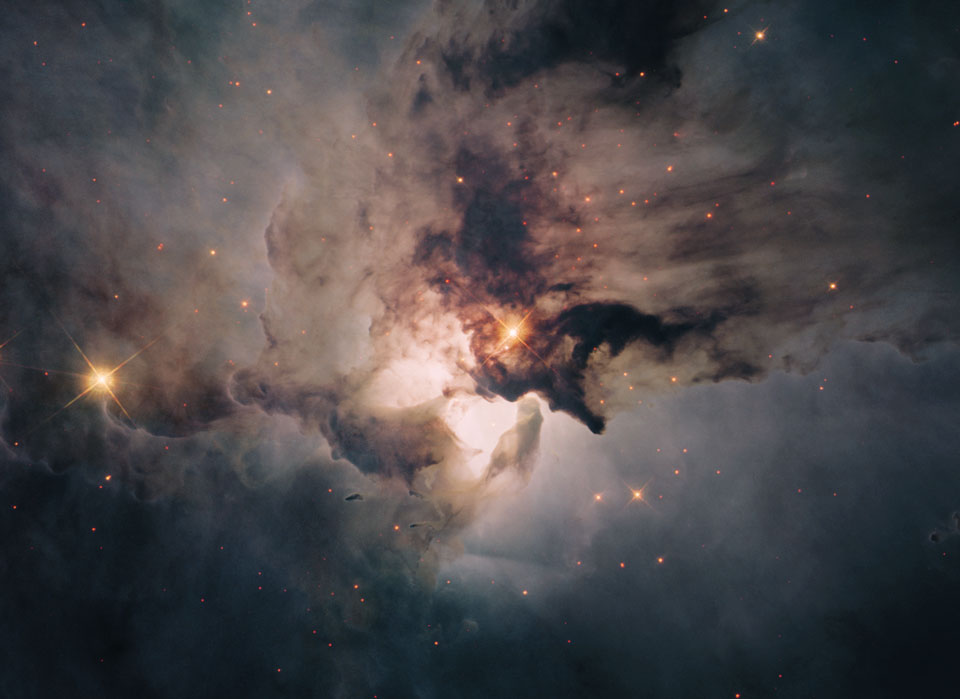 The center of the Lagoon Nebula is a whirlwind of spectacular star formation. Visible near the image center, at least two long funnel-shaped clouds, each roughly half a light-year long, have been formed by extreme stellar winds and intense energetic starlight. The tremendously bright nearby star, Hershel 36, lights the area. Walls of dust hide and redden other hot young stars. As energy from these stars pours into the cool dust and gas, large temperature differences in adjoining regions can be created generating shearing winds which may cause the funnels. This picture, spanning about 5 light years, combines images taken by the orbiting Hubble Space Telescope. The Lagoon Nebula, also known as M8, lies about 5,000 light years distant toward the constellation of Sagittarius.
__________________
1st in Kommisar's 2009 SM Tournament 1st in I Love You`s 2009 New Year`s Tournament 3rd in EnR's Mashfest '08 tournament 5th in Phynx's Unofficial FFR Tournament 9th in D3 of the 2008-2009 4th Official FFR Tournament 10th in D5 of the 2010 5th Official FFR Tournament 10th in D6 of the 2011-2012 6th Official FFR Tournament FMO AAA Count: 71 FGO AAA Count: 10 Bluearrowll = The Canadian player who can not detect awkward patterns. If it's awkward for most people, it's normal for Terry. If the file is difficult but super straight forward, he has issues. If he's AAAing a FGO but then heard that his favorite Hockey team was losing by a point, Hockey > FFR PS: Cool AAA's Terry - I Love You An Alarm Clock's Haiku beep beep beep beep beep beep beep beep beep beep beep beep beep beep beep beep beep - ieatyourlvllol |
|
|

|
|
|
#1027 |
|
⊙▃⊙
|
Daily Suspicious0bserver's Weather Post:
August 21, 2014 What's in the sky tonight? August 21, 2014 -As soon as the stars come out, the Great Square of Pegasus stands low in the east. It's balancing on one corner, and your fist at arm's length fits inside it. It rises higher through the evening and floats highest overhead around 2 or 3 a.m. -For the past month, the sun has been mostly quiet with only a smattering of C- and B-class solar flares. As flares go, these are puny. In fact, when the sun is crackling with flares no stronger than B-class, we often say that "solar activity is very low." But is it, really? A B-class solar flare packs a bigger punch than is generally supposed. Consider this specimen photographed by Harald Paleske of Wei▀enfels/ OT Langendorf, Germany, on August 17th. "This was a B8-class flare in sunspot AR2144," says Paleske. "Despite poor seeing, I was able to capture a high-resolution view of the explosion using my 225mm Unigraph solartelescope." The violence frozen in these snapshots belies the idea that this was a weak explosion. And indeed it was not. A typical B-class solar flare releases as much energy as 100 million WWII atomic bombs. Only on the sun, which is itself a 1027 ton self-contained nuclear explosion, would such a blast be considered puny. So the next time you hear that the forecast calls for "low solar activity," remember ... everything is relative. Today's forecast, by the way, calls for low solar activity with only a 10% chance of M-class solar flares. 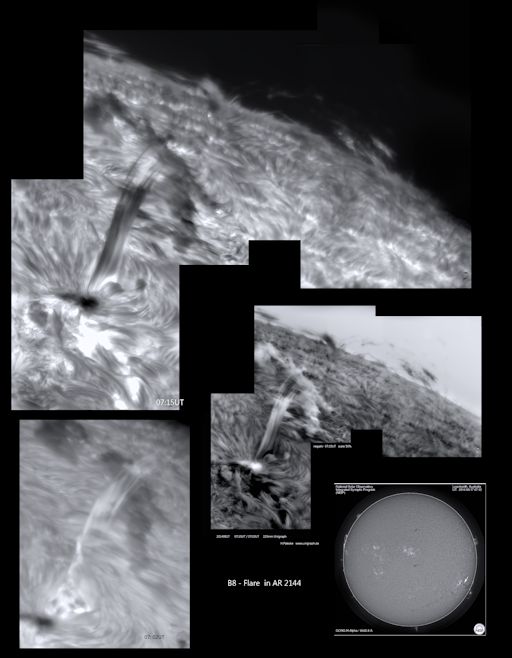 Astro Picture of the Day: August 21, 2014  On Monday morning, Venus and Jupiter gathered close in dawn skies, for some separated by about half the width of a full moon. It was their closest conjunction since 2000, captured here above the eastern horizon before sunrise. The serene and colorful view is from Istia beach near the city of Capoliveri on the island of Elba. Distant lights and rolling hills are along Italy's Tuscan coast. Of course, the celestial pair soon wandered apart. Brighter Venus headed lower, toward the eastern horizon and the glare of the Sun, while Jupiter continues to rise a little higher now in the sky near dawn. The two brightest planets meet again next June 30th, in the evening twilight above the western horizon.
__________________
1st in Kommisar's 2009 SM Tournament 1st in I Love You`s 2009 New Year`s Tournament 3rd in EnR's Mashfest '08 tournament 5th in Phynx's Unofficial FFR Tournament 9th in D3 of the 2008-2009 4th Official FFR Tournament 10th in D5 of the 2010 5th Official FFR Tournament 10th in D6 of the 2011-2012 6th Official FFR Tournament FMO AAA Count: 71 FGO AAA Count: 10 Bluearrowll = The Canadian player who can not detect awkward patterns. If it's awkward for most people, it's normal for Terry. If the file is difficult but super straight forward, he has issues. If he's AAAing a FGO but then heard that his favorite Hockey team was losing by a point, Hockey > FFR PS: Cool AAA's Terry - I Love You An Alarm Clock's Haiku beep beep beep beep beep beep beep beep beep beep beep beep beep beep beep beep beep - ieatyourlvllol Last edited by Bluearrowll; 08-21-2014 at 06:06 AM.. |
|
|

|
|
|
#1028 |
|
⊙▃⊙
|
Daily Suspicious0bserver's Weather Post:
August 22, 2014 What's in the sky tonight? August 22, 2014 -Altair is the brightest star shining halfway up the southeastern sky after nightfall. Look to its left, by a little more than a fist at arm's length, for the dim but distinctive constellation Delphinus, the Dolphin. He's leaping leftward, just below the Milky Way. -In Saturday's dawn, the thin waning crescent Moon forms an elegant triangle with Jupiter and Venus low in the east, as shown at lower right. -Visually, the CME that struck Earth's magnetic field on August 19th was dim and unimpressive. The auroras it produced were magnificent. "For the first time in my life, I saw the Northern Lights," says Tadas Janušonis who sends this photo from Vabalninkas, Lithuania. "It is a very rare phenomenon here in Lithuania," he says, "but the August 19th impact was strong enough to [produce] them." Actually, the impact was weak. A CME like this one hits with a mechanical pressure of no more than 1 or 2 nanoPascals. That's 1 or 2 billionths of a Pascal - softer than a baby's breath. The reason it was so effective had more to do with its inner magnetic structure. This CME contained a region of south-pointing magnetism that partially canceled Earth's north-pointing magnetic field, opening a crack in the magnetosphere. Solar wind poured and fueled the display.  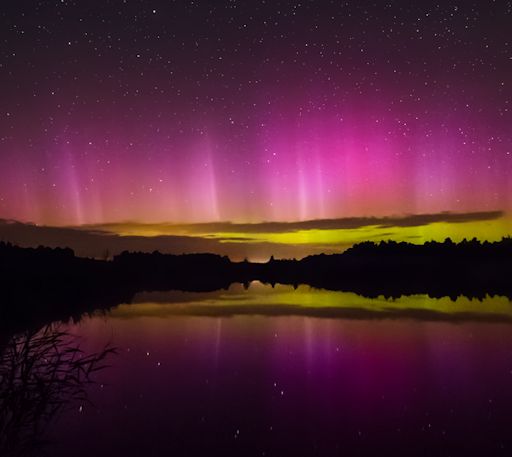 Astro Picture of the Day: August 22, 2014  On July 13th, a good place to watch Comet Jacques was from Venus. Then, the recently discovered visitor (C/2014 E2) to the inner solar system passed within about 14.5 million kilometers of our sister planet. Still, the outbound comet will pass only 84 million kilometers from our fair planet on August 28 and is already a fine target for telescopes and binoculars. Two days ago, Jacques' greenish coma and straight and narrow ion tail were captured in this telescopic snapshot, a single 2 minute long exposure with a modified digital camera. The comet is flanked by IC 1805 and IC 1848, also known as Cassiopeia's Heart and Soul Nebulae. If you're stuck on planet Earth this weekend you can hunt for Comet Jacques in evening skies, or spot a Venus, Jupiter, crescent Moon triangle before the dawn.
__________________
1st in Kommisar's 2009 SM Tournament 1st in I Love You`s 2009 New Year`s Tournament 3rd in EnR's Mashfest '08 tournament 5th in Phynx's Unofficial FFR Tournament 9th in D3 of the 2008-2009 4th Official FFR Tournament 10th in D5 of the 2010 5th Official FFR Tournament 10th in D6 of the 2011-2012 6th Official FFR Tournament FMO AAA Count: 71 FGO AAA Count: 10 Bluearrowll = The Canadian player who can not detect awkward patterns. If it's awkward for most people, it's normal for Terry. If the file is difficult but super straight forward, he has issues. If he's AAAing a FGO but then heard that his favorite Hockey team was losing by a point, Hockey > FFR PS: Cool AAA's Terry - I Love You An Alarm Clock's Haiku beep beep beep beep beep beep beep beep beep beep beep beep beep beep beep beep beep - ieatyourlvllol |
|
|

|
|
|
#1029 |
|
⊙▃⊙
|
Daily Suspicious0bserver's Weather Post:
August 23, 2014 What's in the sky tonight? August 23, 2014 -August is prime Milky Way time. After dark, the Milky Way runs from Sagittarius and Scorpius in the south-southwest, up and left across Aquila and through the big Summer Triangle very high in the southeast and east, and on down through Cassiopeia to Perseus rising low in the north-northeast. -Europe's Rosetta probe has been at Comet 67P/Churyumov-Gerasimenko for two weeks, taking close-up pictures and making measurements of the comet's strange landscape. According to ESA, researchers now have the data they need to start picking a landing site. This weekend, mission planners will meet to consider 10 candidate locations, with the goal of narrowing the list to 5 by Monday. Astro Picture of the Day: August 23, 2014 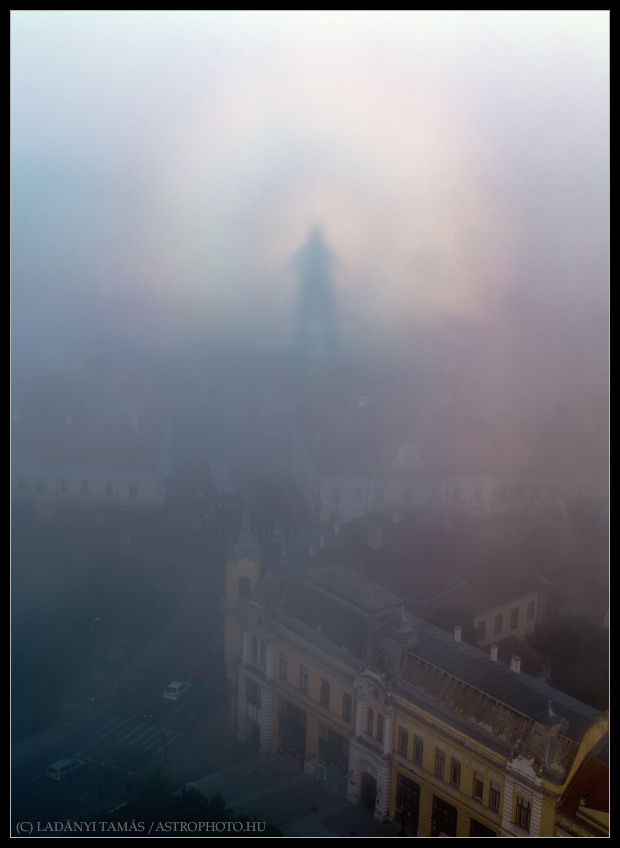 The city of Veszprem, Hungary was only briefly haunted by this mysterious spectre. On the morning of August 11, its monstrous form hovered in the mist above municipal buildings near the town center. A clue to its true identity is offered by the photographer, though, who reports he took the picture from the top of a twenty story building with the rising Sun directly at his back. That special geometry suggests this is an example of an atmospheric phenomenon called the Glory or sometimes "the Spectre of the Brocken". Also seen from mountain tops and airplanes when looking opposite the Sun, the dramatic apparition is the observer's shadow on clouds or fog, the small droplets of water scattering light back towards the Sun through complex internal reflections. Careful night sky watchers can also encounter this spectre's analog in astronomy, a brightening of zodiacal light opposite the Sun known as the gegenschein.
__________________
1st in Kommisar's 2009 SM Tournament 1st in I Love You`s 2009 New Year`s Tournament 3rd in EnR's Mashfest '08 tournament 5th in Phynx's Unofficial FFR Tournament 9th in D3 of the 2008-2009 4th Official FFR Tournament 10th in D5 of the 2010 5th Official FFR Tournament 10th in D6 of the 2011-2012 6th Official FFR Tournament FMO AAA Count: 71 FGO AAA Count: 10 Bluearrowll = The Canadian player who can not detect awkward patterns. If it's awkward for most people, it's normal for Terry. If the file is difficult but super straight forward, he has issues. If he's AAAing a FGO but then heard that his favorite Hockey team was losing by a point, Hockey > FFR PS: Cool AAA's Terry - I Love You An Alarm Clock's Haiku beep beep beep beep beep beep beep beep beep beep beep beep beep beep beep beep beep - ieatyourlvllol Last edited by Bluearrowll; 08-23-2014 at 10:59 AM.. |
|
|

|
|
|
#1030 |
|
⊙▃⊙
|
Daily Suspicious0bserver's Weather Post:
August 24, 2014 What's in the sky tonight? August 24, 2014 -Mars and Saturn are closest together this evening and Monday evening, separated by 3.4░. They're the same brightness but not the same color. And compare Mars's color to that of its rival Antares, not quite as bright, in Scorpius about 20░ to the left. (See the last illustration below.) Mars will pass Antares by just 3░ in late September. -On Saturday morning, Aug. 23rd, Venus, Jupiter and the crescent Moon converged to form a bright triangle in the pre-dawn sky. On Sunday morning the triangle dispersed. Pete Lawrence photographed the break-up from the seashore in Selsey, West Sussex, UK. "Venus and Jupiter were easy targets this morning, but the thin (4%) crescent Moon was a different matter!" says Lawrence. "It was almost invisible in the red glow of sunrise." (can't find the moon in the image below? http://puu.sh/b5Ol2/77db7e425b.jpg ) -Did you oversleep on Saturday? No problem. Another "celestial triangle" is in the offing. Right now the Moon is passing the sun en route to the evening sky. On August 31st it will join Mars and Saturn in the constellation Libra. Visible after sunset, the new triangle won't be quite as luminous as the old one, because Mars + Saturn is not as bright as Venus + Jupiter, but the formaton will still be very pretty. 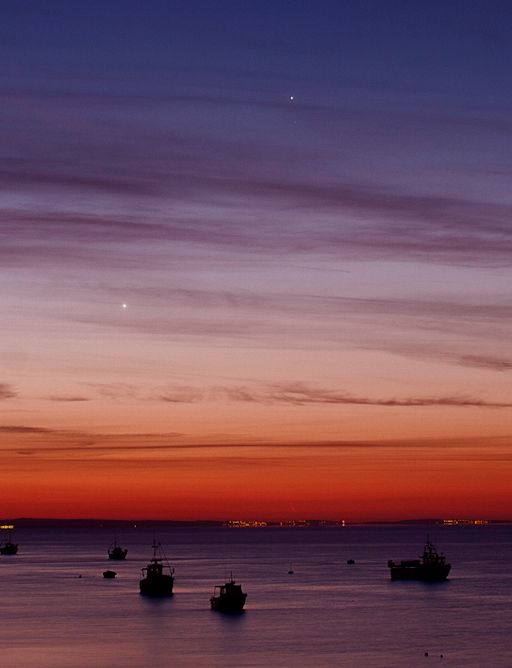 Astro Picture of the Day: August 24, 2014  What's that dot on the Sun? If you look closely, it is almost perfectly round. The dot is the result of an unusual type of solar eclipse that occurred in 2006. Usually it is the Earth's Moon that eclipses the Sun. This time, the planet Mercury took a turn. Like the approach to New Moon before a solar eclipse, the phase of Mercury became a continually thinner crescent as the planet progressed toward an alignment with the Sun. Eventually the phase of Mercury dropped to zero and the dark spot of Mercury crossed our parent star. The situation could technically be labeled a Mercurian annular eclipse with an extraordinarily large ring of fire. From above the cratered planes of the night side of Mercury, the Earth appeared in its fullest phase. Hours later, as Mercury continued in its orbit, a slight crescent phase appeared again. The next Mercurian solar eclipse will occur in 2016.
__________________
1st in Kommisar's 2009 SM Tournament 1st in I Love You`s 2009 New Year`s Tournament 3rd in EnR's Mashfest '08 tournament 5th in Phynx's Unofficial FFR Tournament 9th in D3 of the 2008-2009 4th Official FFR Tournament 10th in D5 of the 2010 5th Official FFR Tournament 10th in D6 of the 2011-2012 6th Official FFR Tournament FMO AAA Count: 71 FGO AAA Count: 10 Bluearrowll = The Canadian player who can not detect awkward patterns. If it's awkward for most people, it's normal for Terry. If the file is difficult but super straight forward, he has issues. If he's AAAing a FGO but then heard that his favorite Hockey team was losing by a point, Hockey > FFR PS: Cool AAA's Terry - I Love You An Alarm Clock's Haiku beep beep beep beep beep beep beep beep beep beep beep beep beep beep beep beep beep - ieatyourlvllol |
|
|

|
|
|
#1031 |
|
⊙▃⊙
|
Daily Suspicious0bserver's Weather Post:
August 25, 2014 What's in the sky tonight? August 25, 2014 -Have you ever wondered what a lunchbox suspended 112,000 feet above Earth's surface would look like? The answer is, this: -This is actually a Space Weather Buoy--a lunchbox containing a cosmic ray detector, cameras, GPS trackers, a thermometer and other sensors. It flew to the stratosphere on August 22nd tethered to a suborbital helium balloon. In collaboration with Spaceweather.com, the students of Earth to Sky Calculus have been launching these buoys on a regular basis to study the effect of solar activity on Earth's upper atmosphere. Soon, they will release results from a year-long campaign covering altitudes of interest to aviation, space tourism, and ozone research. The students wish to thank Eden Botanicals for sponsoring the August 22nd flight. (Note their logo on the corner of the payload.) This was the student group's 58th successful launch--almost all paid for by a combination of donations and commercial advertising. If you would like your own logo sent to the stratosphere, visit the spaceweather.com website and contact dr.tony.phillips@earthlink.net . 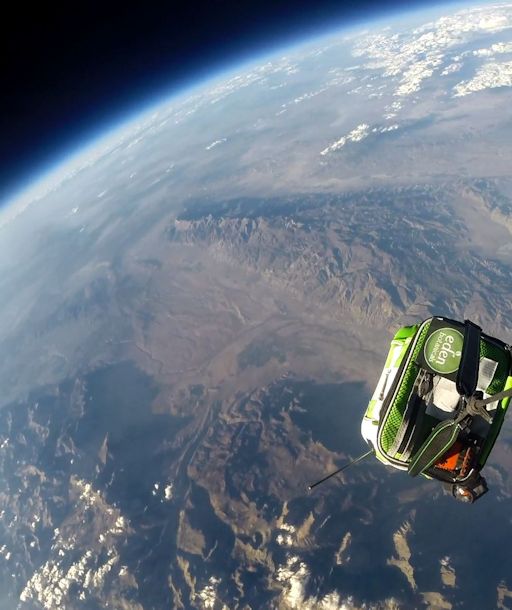 Astro Picture of the Day: August 25, 2014  Why does this galaxy have such a long tail? In this stunning vista, based on image data from the Hubble Legacy Archive, distant galaxies form a dramatic backdrop for disrupted spiral galaxy Arp 188, the Tadpole Galaxy. The cosmic tadpole is a mere 420 million light-years distant toward the northern constellation Draco. Its eye-catching tail is about 280 thousand light-years long and features massive, bright blue star clusters. One story goes that a more compact intruder galaxy crossed in front of Arp 188 - from right to left in this view - and was slung around behind the Tadpole by their gravitational attraction. During the close encounter, tidal forces drew out the spiral galaxy's stars, gas, and dust forming the spectacular tail. The intruder galaxy itself, estimated to lie about 300 thousand light-years behind the Tadpole, can be seen through foreground spiral arms at the upper right. Following its terrestrial namesake, the Tadpole Galaxy will likely lose its tail as it grows older, the tail's star clusters forming smaller satellites of the large spiral galaxy.
__________________
1st in Kommisar's 2009 SM Tournament 1st in I Love You`s 2009 New Year`s Tournament 3rd in EnR's Mashfest '08 tournament 5th in Phynx's Unofficial FFR Tournament 9th in D3 of the 2008-2009 4th Official FFR Tournament 10th in D5 of the 2010 5th Official FFR Tournament 10th in D6 of the 2011-2012 6th Official FFR Tournament FMO AAA Count: 71 FGO AAA Count: 10 Bluearrowll = The Canadian player who can not detect awkward patterns. If it's awkward for most people, it's normal for Terry. If the file is difficult but super straight forward, he has issues. If he's AAAing a FGO but then heard that his favorite Hockey team was losing by a point, Hockey > FFR PS: Cool AAA's Terry - I Love You An Alarm Clock's Haiku beep beep beep beep beep beep beep beep beep beep beep beep beep beep beep beep beep - ieatyourlvllol |
|
|

|
|
|
#1032 |
|
⊙▃⊙
|
Daily Suspicious0bserver's Weather Post:
August 26, 2014 What's in the sky tonight? August 26, 2014 -If you're in the Earth's mid-northern latitudes, bright Vega shines near your zenith just as night becomes fully dark. Whenever you see Vega most nearly straight up, you know that Sagittarius, with its deep-sky riches, is at its highest in the south. -Yesterday, active sunspot AR2148 erupted twice, producing a rapidfire pair of M-class solar flares (M2 @ 1511 UT and M3 @ 2021 UT). The Solar and Heliospheric Observatory recorded a corresponding pair of CMEs emerging from the blast site. According to NOAA analysts, the first CME does not have an Earth-directed component. The second CME looks even less Earth-directed than the first. In short, they missed. More eruptions may be in the offing. Sunspots AR2146 and AR2149 both have complex magnetic fields that harbor energy for strong flares. NOAA forecasters estimate a 55% chance of M-class flares and 10% chance of X-flares on August 26th. 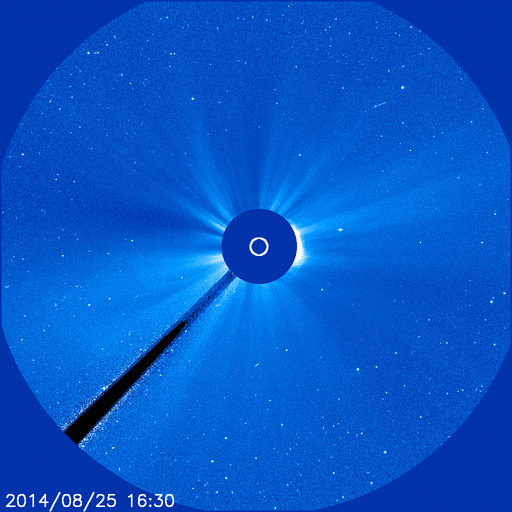 Astro Picture of the Day: August 26, 2014 What would it look like to fly past Triton, the largest moon of planet Neptune? Only one spacecraft has ever done this -- and now, for the first time, images of this dramatic encounter have been gathered into a movie. On 1989 August 25, the Voyager 2 spacecraft shot through the Neptune system with cameras blazing. Triton is slightly smaller than Earth's Moon but has ice volcanoes and a surface rich in frozen nitrogen. The first sequence in the video shows Voyager's approach to Triton, which, despite its unusual green tint, appears in approximately true color. The mysterious terrain seen under the spacecraft soon changed from light to dark, with the terminator of night soon crossing underneath. After closest approach, Voyager pivoted to see the departing moon, now visible as a diminishing crescent. Next July, assuming all goes well, the robotic New Horizons spacecraft will make a similar flight past Pluto, an orb of similar size to Triton.
__________________
1st in Kommisar's 2009 SM Tournament 1st in I Love You`s 2009 New Year`s Tournament 3rd in EnR's Mashfest '08 tournament 5th in Phynx's Unofficial FFR Tournament 9th in D3 of the 2008-2009 4th Official FFR Tournament 10th in D5 of the 2010 5th Official FFR Tournament 10th in D6 of the 2011-2012 6th Official FFR Tournament FMO AAA Count: 71 FGO AAA Count: 10 Bluearrowll = The Canadian player who can not detect awkward patterns. If it's awkward for most people, it's normal for Terry. If the file is difficult but super straight forward, he has issues. If he's AAAing a FGO but then heard that his favorite Hockey team was losing by a point, Hockey > FFR PS: Cool AAA's Terry - I Love You An Alarm Clock's Haiku beep beep beep beep beep beep beep beep beep beep beep beep beep beep beep beep beep - ieatyourlvllol |
|
|

|
|
|
#1033 |
|
⊙▃⊙
|
Daily Suspicious0bserver's Weather Post:
August 27, 2014 What's in the sky tonight? August 27, 2014 -Arctic sky watchers should be alert for auroras. Currently, solar wind conditions favor geomagnetic activity at high-latitudes, sparking Northern Lights bright enough to shine through the late-summer twilight. Mike Theiss sends this picture from the east coast of Iceland. "The lights were incredible," says Theiss. "They changed intensity on and off for about 3 hours on Aug. 27th." These auroras signal the arrival of a CME launched toward Earth on Aug. 22nd. As NOAA analysts predicted, the solar wind speed did not change much in response to the CME. However, the storm cloud contained a south-pointing magnetic field that opened a crack in Earth's magnetosphere. Solar wind is pouring in to fuel the ongoing display. -orking over the weekend, Rosetta mission planners and scientists narrowed a list of 10 candidate landing sites to only 5. They are circled in this image of the core of 67P/Churyumov-Gerasimenko. In mid-November, Rosetta's Philae lander will attempt to touch down in one of these locations--the first time humankind has ever landed a probe on the core of a comet. The candidate sites are distributed as follows: three (I, B and J) on the comet's smaller lobe and two (A and C) on the larger. The comet's canyon-like neck has been excluded. All of the candidate landing sites provide at least six hours of daylight per comet rotation and offer some flat terrain. According to the ESA, every site has the potential for unique scientific discoveries by the lander's 10 instruments. A full discussion of each site may be found in this ESA press release. By September 14th, the five candidates will have been assessed and ranked, leading to the selection of a primary landing site, for which a fully detailed strategy for the landing operations will be developed, along with a backup. 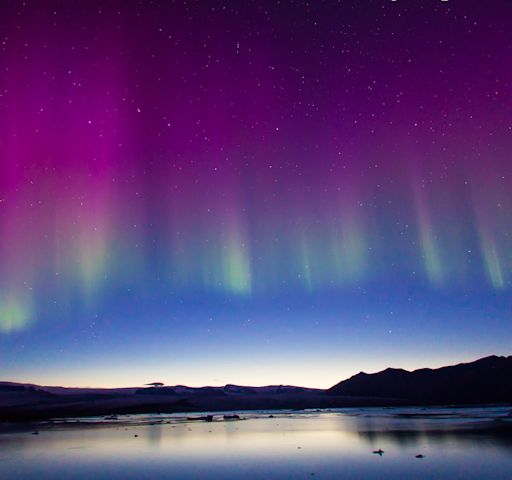 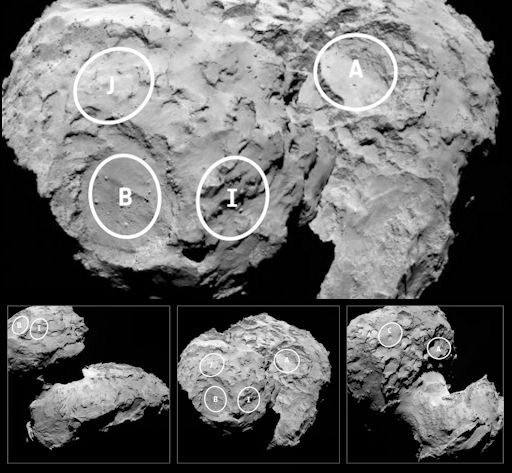 Astro Picture of the Day: August 27, 2014  The Milky Way was not created by an evaporating lake. The colorful pool of water, about 10 meters across, is known as Silex Spring and is located in Yellowstone National Park in Wyoming, USA. Illuminated artificially, the colors are caused by layers of bacteria that grow in the hot spring. Steam rises off the spring, heated by a magma chamber deep underneath known as the Yellowstone hotspot. Unrelated and far in the distance, the central band of our Milky Way Galaxy arches high overhead, a band lit by billions of stars. The above picture is a 16-image panorama taken late last month. If the Yellowstone hotspot causes another supervolcanic eruption as it did 640,000 years ago, a large part of North America would be affected.
__________________
1st in Kommisar's 2009 SM Tournament 1st in I Love You`s 2009 New Year`s Tournament 3rd in EnR's Mashfest '08 tournament 5th in Phynx's Unofficial FFR Tournament 9th in D3 of the 2008-2009 4th Official FFR Tournament 10th in D5 of the 2010 5th Official FFR Tournament 10th in D6 of the 2011-2012 6th Official FFR Tournament FMO AAA Count: 71 FGO AAA Count: 10 Bluearrowll = The Canadian player who can not detect awkward patterns. If it's awkward for most people, it's normal for Terry. If the file is difficult but super straight forward, he has issues. If he's AAAing a FGO but then heard that his favorite Hockey team was losing by a point, Hockey > FFR PS: Cool AAA's Terry - I Love You An Alarm Clock's Haiku beep beep beep beep beep beep beep beep beep beep beep beep beep beep beep beep beep - ieatyourlvllol |
|
|

|
|
|
#1034 |
|
⊙▃⊙
|
Daily Suspicious0bserver's Weather Post:
August 28, 2014 What's in the sky tonight? August 28, 2014 -The Great Square of Pegasus is now well up in the east as soon as nightfall is complete. It's larger than your fist at arm's length and currently stands on one corner. Seen from your latitude at your time, how close is the balance to perfect? -Go outside just after sunset and look southwest. Something there will make you do a double-take. Mars and Saturn have converged alongside the second brightest star in Libra to form a pretty twilight triangle. "It was an amazing triangle," says photographer Marek Nikodem of Szubin, Poland. The planets are labeled in Nikodem's photo, but that star is not. That's because its name wouldn't fit. The second brightest star in Libra is Zubenelgenubi. Pronounced "zoo-BEN-el-je-NEW-bee," it is a double star 77 light years from Earth easily split by binoculars or a small backyard telescope. Soon, the threesome will become a foursome. The crescent Moon will pass through the triangle on August 30th and 31st. On those evenings, in the time it takes to scan your telescope around a small patch of sky, you can see a double star, the rings of Saturn, the red disk of Mars, and the cratered landscape of the Moon. Mark your calendar! 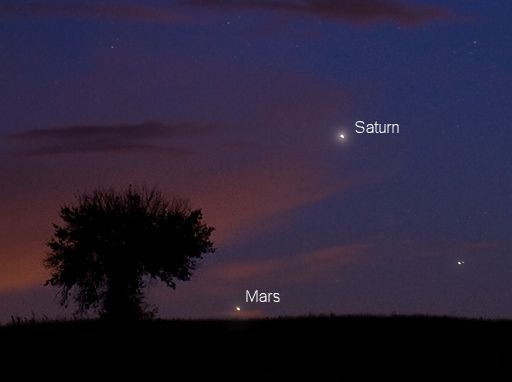 Astro Picture of the Day: August 28, 2014 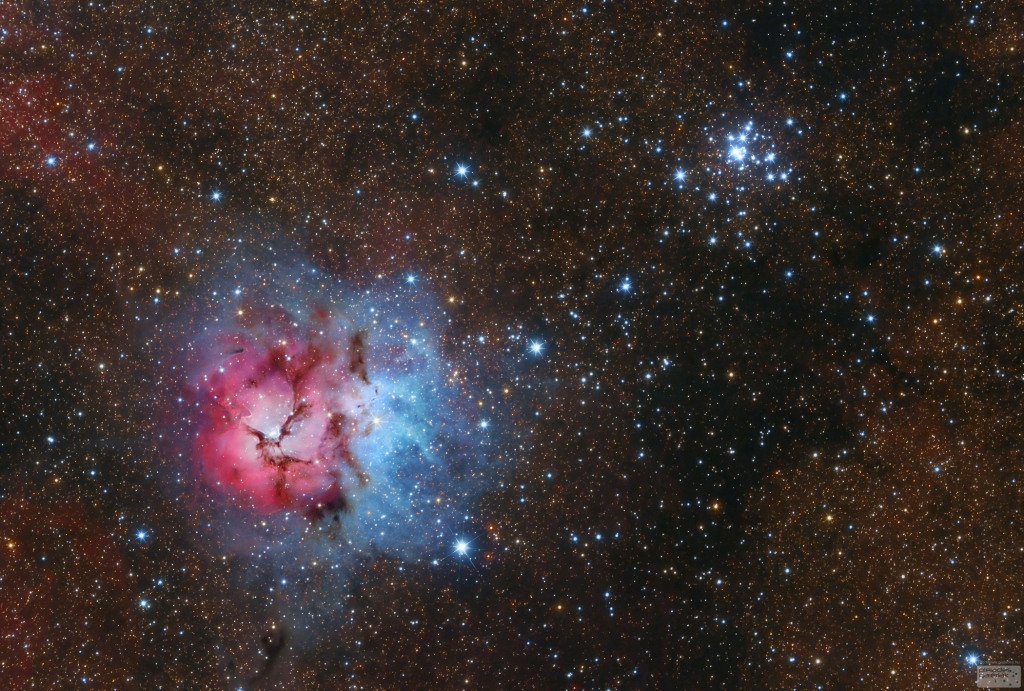 The beautiful Trifid Nebula, also known as Messier 20, is easy to find with a small telescope in the nebula rich constellation Sagittarius. About 5,000 light-years away, the colorful study in cosmic contrasts shares this well-composed, nearly 1 degree wide field with open star cluster Messier 21 (top right). Trisected by dust lanes the Trifid itself is about 40 light-years across and a mere 300,000 years old. That makes it one of the youngest star forming regions in our sky, with newborn and embryonic stars embedded in its natal dust and gas clouds. Estimates of the distance to open star cluster M21 are similar to M20's, but though they share this gorgeous telescopic skyscape there is no apparent connection between the two. In fact, M21's stars are much older, about 8 million years old.
__________________
1st in Kommisar's 2009 SM Tournament 1st in I Love You`s 2009 New Year`s Tournament 3rd in EnR's Mashfest '08 tournament 5th in Phynx's Unofficial FFR Tournament 9th in D3 of the 2008-2009 4th Official FFR Tournament 10th in D5 of the 2010 5th Official FFR Tournament 10th in D6 of the 2011-2012 6th Official FFR Tournament FMO AAA Count: 71 FGO AAA Count: 10 Bluearrowll = The Canadian player who can not detect awkward patterns. If it's awkward for most people, it's normal for Terry. If the file is difficult but super straight forward, he has issues. If he's AAAing a FGO but then heard that his favorite Hockey team was losing by a point, Hockey > FFR PS: Cool AAA's Terry - I Love You An Alarm Clock's Haiku beep beep beep beep beep beep beep beep beep beep beep beep beep beep beep beep beep - ieatyourlvllol |
|
|

|
|
|
#1035 |
|
⊙▃⊙
|
Daily Suspicious0bserver's Weather Post:
August 29, 2014 What's in the sky tonight? August 29, 2014 -The Moon is coming back into the evening sky. Look for the waxing crescent low in the west-southwest in twilight, as shown at lower right. Can you make out Spica twinkling beneath it? Binoculars help. Far to their upper left are Saturn and Mars. -"After a long summer without stars, the Northern Lights have finally returned," reports Fredrik Broms of Troms°, Norway (70 deg N latitude). "Last night's display was so strong that, although constellations such as Cassiopeia are still only to be made out very faintly on the blue night sky, the auroras shimmered and danced in an explosion of colors!" This is what he saw almost directly overhead around local midnight on August 28th: -The twilight display was sparked by a pair of CME impacts on August 27th. As Earth passed through the wake of the storm clouds, the interplanetary magnetic field (IMF) around Earth tipped south. This opened a crack in our planet's magnetosphere; solar wind poured in to fuel a light show that lasted for nearly three days and nights. NOAA forecasters estimate a 20% chance of polar geomagnetic storms on Aug. 29th as CME effects wane. Arctic sky watchers should remain alert for green in the twilight.  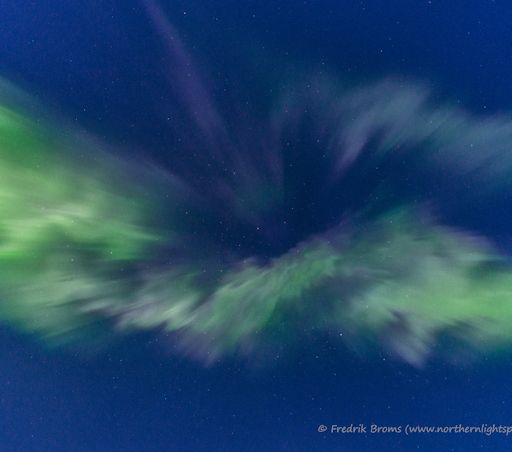 Astro Picture of the Day: August 29, 2014 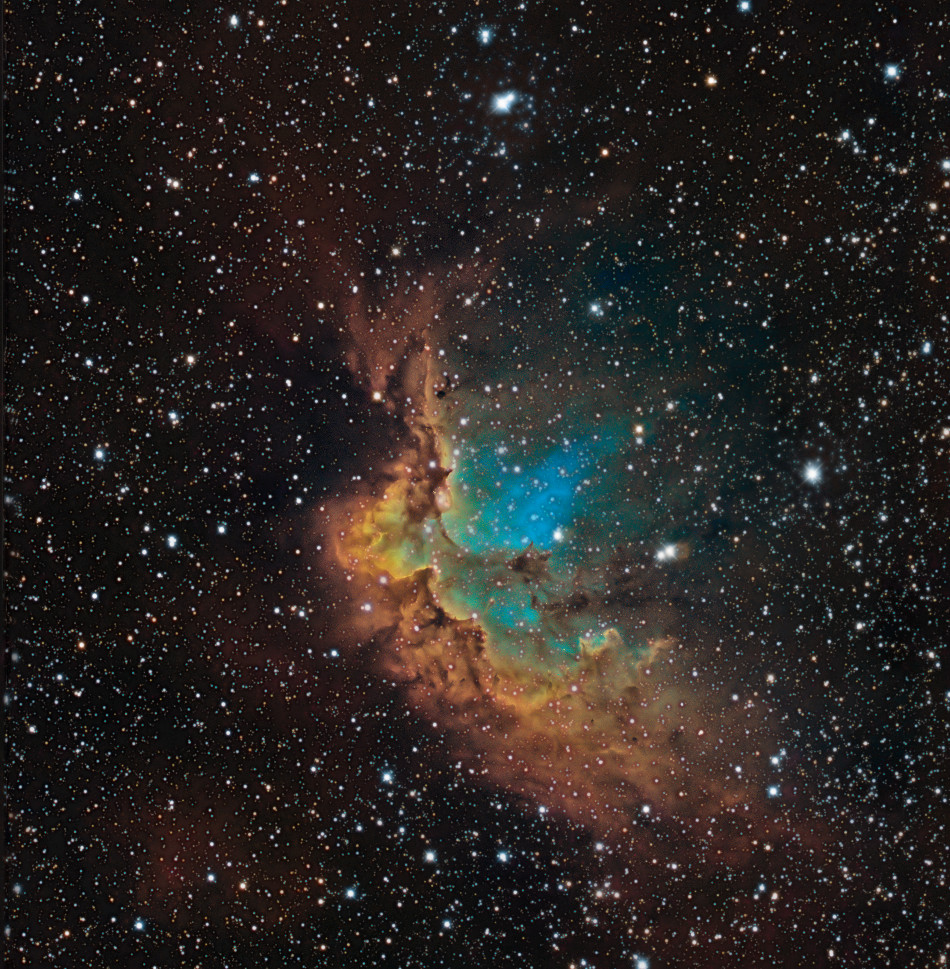 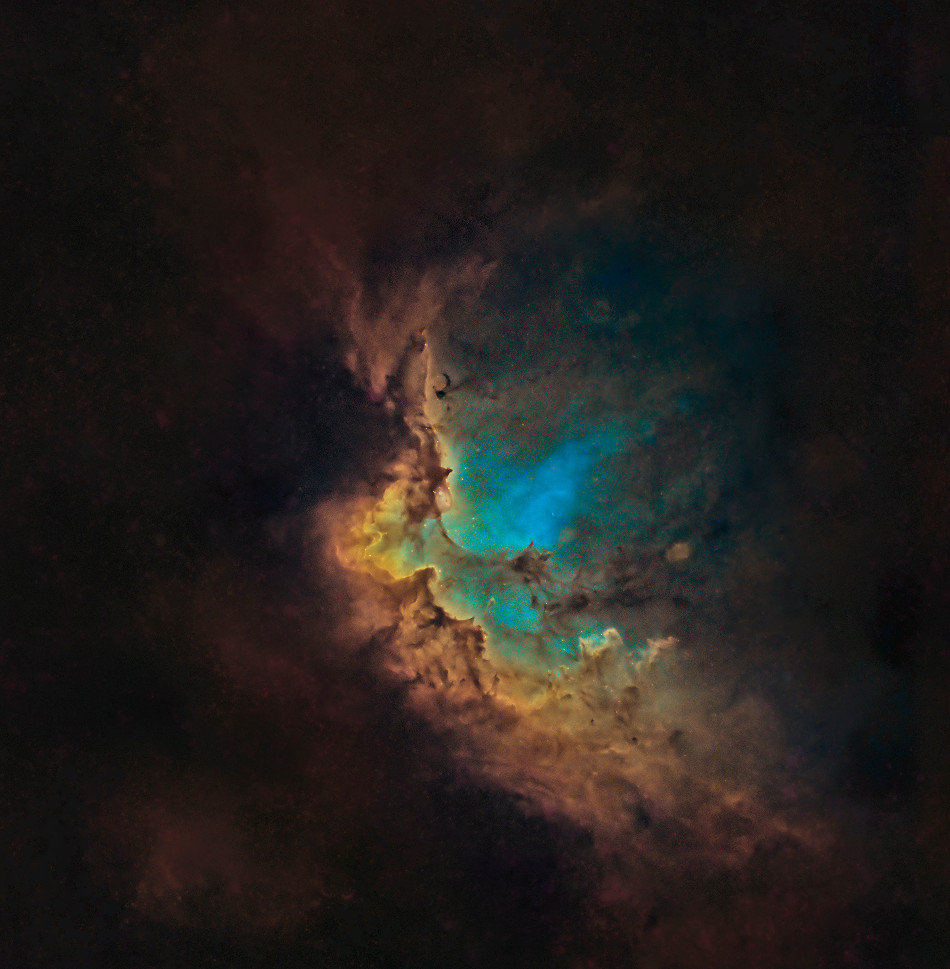 Open star cluster NGC 7380 is still embedded in its natal cloud of interstellar gas and dust popularly known as the Wizard Nebula. Seen with foreground and background stars along the plane of our Milky Way galaxy it lies some 8,000 light-years distant, toward the constellation Cepheus. A full moon would easily fit inside this telescopic view of the 4 million year young cluster and associated nebula, normally much too faint to be seen by eye. Made with telescope and camera firmly planted on Earth, the image reveals multi light-year sized shapes and structures within the Wizard in a color palette made popular in Hubble Space Telescope images. Recorded with narrowband filters, the visible wavelength light from the nebula's hydrogen, oxygen, and sulfur atoms is transformed into green, blue, and red colors in the final digital composite. Daily Suspicious0bserver's Weather Post: August 30, 2014 What's in the sky tonight? August 30, 2014 -The waxing crescent Moon now shines closer to Saturn and Mars, as shown above. Can you see little Alpha Librae in the middle of the narrow triangle they make? -In mid-November, ESA's Rosetta spacecraft will make history by dropping a probe onto the surface of a comet. Bristling with 10 sensors including a camera, the Philae lander will touchdown somewhere on the rugged double-lobed core of comet 67P/Churyumov-Gerasimenko.  Astro Picture of the Day: August 30, 2014 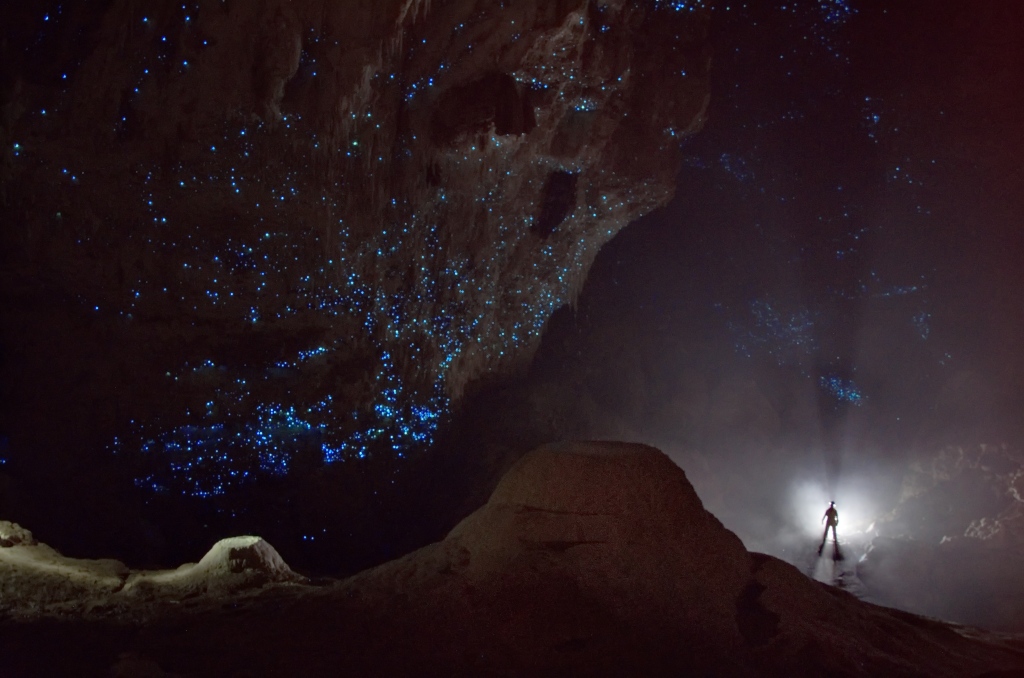 Look up in New Zealand's Hollow Hill Cave and you might think you see a familiar starry sky. And that's exactly what Arachnocampa luminosa are counting on. Captured in this long exposure, the New Zealand glowworms scattered across the cave ceiling give it the inviting and open appearance of a clear, dark night sky filled with stars. Unsuspecting insects fooled into flying too far upwards get trapped in sticky snares the glowworms create and hang down to catch food. Of course professional astronomers wouldn't be so easily fooled, although that does look a lot like the Coalsack Nebula and Southern Cross at the upper left ... Comparison Photo: http://apod.nasa.gov/apod/ap070517.html
__________________
1st in Kommisar's 2009 SM Tournament 1st in I Love You`s 2009 New Year`s Tournament 3rd in EnR's Mashfest '08 tournament 5th in Phynx's Unofficial FFR Tournament 9th in D3 of the 2008-2009 4th Official FFR Tournament 10th in D5 of the 2010 5th Official FFR Tournament 10th in D6 of the 2011-2012 6th Official FFR Tournament FMO AAA Count: 71 FGO AAA Count: 10 Bluearrowll = The Canadian player who can not detect awkward patterns. If it's awkward for most people, it's normal for Terry. If the file is difficult but super straight forward, he has issues. If he's AAAing a FGO but then heard that his favorite Hockey team was losing by a point, Hockey > FFR PS: Cool AAA's Terry - I Love You An Alarm Clock's Haiku beep beep beep beep beep beep beep beep beep beep beep beep beep beep beep beep beep - ieatyourlvllol Last edited by Bluearrowll; 08-31-2014 at 08:34 AM.. |
|
|

|
|
|
#1036 |
|
⊙▃⊙
|
Daily Suspicious0bserver's Weather Post:
August 31, 2014 What's in the sky tonight? August 31, 2014 -Spot the Moon at dusk with Saturn to its right and Mars to its lower left (for North America). -As the stars come out this week, the first you see may be Arcturus shining high in the west. As the sky gets a little darker, look to its right for the Big Dipper scooping down in the northwest. -As northern summer comes to a close, electrical storms are rumbling across the USA. After nightfall, red sprites can be seen dancing across the cloudtops. On Aug. 20th, Tom A. Warner photographed these speciments above New Underwood, South Dakota: "On the night of Aug 20th, intense storms developed in north central South Dakota," says Warner. "Skies cleared out to the west and offered a chance to capture some sprites from the northern activity." He saw not only sprites, but also green-glowing gravity waves. The waves are, literally, the ripple effect of a powerful thunderstorm on the mesosphere some 80 km above Earth's surface. From space, these waves look like a giant atmospheric bull's eye. From the ground, they appear to be green ripples in the sky, as shown in Warner's images. Left to themselves, gravity waves would be invisible to the human eye. We see them, however, because they are colored green by an aurora-like phenomenon called "airglow." Airglow is caused by an assortment of chemical reactions in the upper atmosphere driven mainly by solar ultraviolet radiation. Gravity waves rippling away from the central axis of a thunderstorm cause temperature and density perturbations in the upper atmosphere. Speaking simplistically, those perturbations alter the chemical reaction rates of airglow, leading to more-bright or less-bright bands depending on whether the rates are boosted or diminished, respectively. Inhabiting the upper reaches of Earth's atmosphere alongside meteors, noctilucent clouds and some auroras, sprites and mesospheric gravity waves are true space weather phenomena. Now is a good time to see them.  Astro Picture of the Day: August 31, 2014  How was this picture taken? Usually, pictures of the shuttle, taken from space, are snapped from the space station. Commonly, pictures of the space station are snapped from the shuttle. How, then, can there be a picture of both the shuttle and the station together, taken from space? The answer is that during the Space Shuttle Endeavour's last trip to the International Space Station in 2011 May, a supply ship departed the station with astronauts that captured a series of rare views. The supply ship was the Russian Soyuz TMA-20 which landed in Kazakhstan later that day. The above spectacular image well captures the relative sizes of the station and docked shuttle. Far below, clouds of Earth are seen above a blue sea.
__________________
1st in Kommisar's 2009 SM Tournament 1st in I Love You`s 2009 New Year`s Tournament 3rd in EnR's Mashfest '08 tournament 5th in Phynx's Unofficial FFR Tournament 9th in D3 of the 2008-2009 4th Official FFR Tournament 10th in D5 of the 2010 5th Official FFR Tournament 10th in D6 of the 2011-2012 6th Official FFR Tournament FMO AAA Count: 71 FGO AAA Count: 10 Bluearrowll = The Canadian player who can not detect awkward patterns. If it's awkward for most people, it's normal for Terry. If the file is difficult but super straight forward, he has issues. If he's AAAing a FGO but then heard that his favorite Hockey team was losing by a point, Hockey > FFR PS: Cool AAA's Terry - I Love You An Alarm Clock's Haiku beep beep beep beep beep beep beep beep beep beep beep beep beep beep beep beep beep - ieatyourlvllol |
|
|

|
|
|
#1037 |
|
⊙▃⊙
|
Daily Suspicious0bserver's Weather Post:
September 1, 2014 What's in the sky tonight? September 1, 2014 -First-quarter Moon this evening and Tuesday evening (exactly first quarter at 7:11 a.m. Eastern Daylight Time Tuesday morning). It's passing over Scorpius, as shown below. -After a long, long summer day, Arctic skies are darkening again, and in the sunset observers are seeing rays of green in the twilight blue. Frank Olsen of Sortland, Norway, took this picture at sunset on Aug. 31st. "I went out last night to catch the sunset--but mostly the auroras," says Olsen. "Even before it was dark, the Northern Lights made an appearance." More lights are in the offing. NOAA forecasters estimate a 20% of polar geomagnetic storms during the next 24 hours. The odds of Arctic auroras are higher, however, because it doesn't take a full-fledged storm to turn the twilight green at polar latitudes.  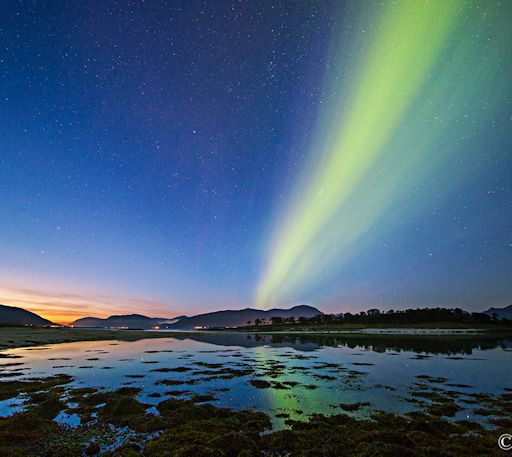 Astro Picture of the Day: September 1, 2014  Why would the sky look like a giant target? Airglow. Following a giant thunderstorm over Bangladesh in late April, giant circular ripples of glowing air appeared over Tibet, China, as pictured above. The unusual pattern is created by atmospheric gravity waves, waves of alternating air pressure that can grow with height as the air thins, in this case about 90 kilometers up. Unlike auroras powered by collisions with energetic charged particles and seen at high latitudes, airglow is due to chemiluminescence, the production of light in a chemical reaction. More typically seen near the horizon, airglow keeps the night sky from ever being completely dark.
__________________
1st in Kommisar's 2009 SM Tournament 1st in I Love You`s 2009 New Year`s Tournament 3rd in EnR's Mashfest '08 tournament 5th in Phynx's Unofficial FFR Tournament 9th in D3 of the 2008-2009 4th Official FFR Tournament 10th in D5 of the 2010 5th Official FFR Tournament 10th in D6 of the 2011-2012 6th Official FFR Tournament FMO AAA Count: 71 FGO AAA Count: 10 Bluearrowll = The Canadian player who can not detect awkward patterns. If it's awkward for most people, it's normal for Terry. If the file is difficult but super straight forward, he has issues. If he's AAAing a FGO but then heard that his favorite Hockey team was losing by a point, Hockey > FFR PS: Cool AAA's Terry - I Love You An Alarm Clock's Haiku beep beep beep beep beep beep beep beep beep beep beep beep beep beep beep beep beep - ieatyourlvllol |
|
|

|
|
|
#1038 |
|
⊙▃⊙
|
Daily Suspicious0bserver's Weather Post:
September 2, 2014 What's in the sky tonight? September 2, 2014 -The Great Square of Pegasus is well up in the east as soon as nightfall is complete. It's larger than your fist at arm's length and currently stands on one corner. Seen from your latitude at your time, how close is its balance to being perfect? -A sunspot located just behind the sun's northeastern limb exploded yesterday, Sept. 1st @ 1105 UT, producing "a significant solar flare," according to NOAA analysts. NASA's STEREO-B spacecraft, stationed over the farside of the sun, recorded the extreme ultraviolet flash. A fast CME emerged from the blast site traveling approximately 2000 km/s (4.5 million mph). The flare also produced strong radio bursts and a farside solar proton storm. Only the intervening limb of the sun prevented Earth effects. When flares occur on the Earthside of the sun, we classify them according to their X-ray intensity: C (weak), M (medium), or X (strong). Farside explosions, however, cannot be precisely classified because none of the spacecraft stationed over the farside of the sun are equipped with X-ray sensors. Based on the appearance of the flare at UV wavelengths, plus other factors such as the CME and radiation storm, we would guess that this was a strong-M or X-class event. Soon, the source of the explosion will reveal itself as solar rotation carries it up and over the sun's NE limb. Earth-directed solar activity could be just a few days away.  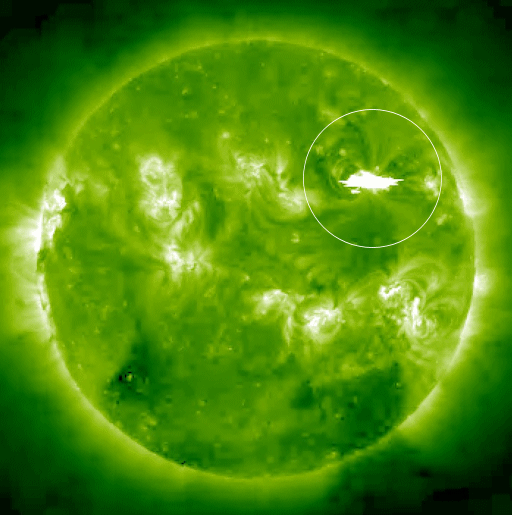 Astro Picture of the Day: September 2, 2014 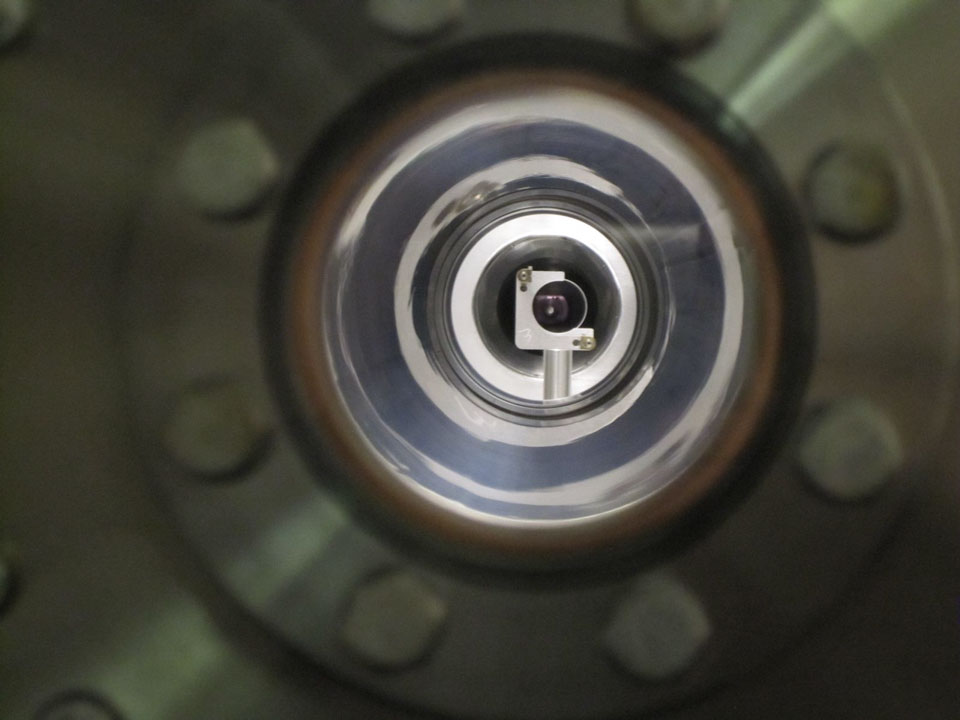 How different are space and time at very small scales? To explore the unfamiliar domain of the miniscule Planck scale -- where normally unnoticeable quantum effects might become dominant -- a newly developed instrument called the Fermilab Holometer has begun operating at the Fermi National Accelerator Laboratory (Fermilab) near Chicago, Illinois, USA. The instrument seeks to determine if slight but simultaneous jiggles of a mirror in two directions expose a fundamental type of holographic noise that always exceeds a minimum amount. Pictured above is one of the end mirrors of a Holometer prototype. Although the discovery of holographic noise would surely be groundbreaking, the dependence of such noise on a specific laboratory length scale would surprise some spacetime enthusiasts. One reason for this is the Lorentz Invariance postulate of Einstein's special relativity, which states that all length scales should appear contracted to a relatively moving observer -- even the diminutive Planck length. Still, the experiment is unique and many are curious what the results will show.
__________________
1st in Kommisar's 2009 SM Tournament 1st in I Love You`s 2009 New Year`s Tournament 3rd in EnR's Mashfest '08 tournament 5th in Phynx's Unofficial FFR Tournament 9th in D3 of the 2008-2009 4th Official FFR Tournament 10th in D5 of the 2010 5th Official FFR Tournament 10th in D6 of the 2011-2012 6th Official FFR Tournament FMO AAA Count: 71 FGO AAA Count: 10 Bluearrowll = The Canadian player who can not detect awkward patterns. If it's awkward for most people, it's normal for Terry. If the file is difficult but super straight forward, he has issues. If he's AAAing a FGO but then heard that his favorite Hockey team was losing by a point, Hockey > FFR PS: Cool AAA's Terry - I Love You An Alarm Clock's Haiku beep beep beep beep beep beep beep beep beep beep beep beep beep beep beep beep beep - ieatyourlvllol |
|
|

|
|
|
#1039 |
|
⊙▃⊙
|
Daily Suspicious0bserver's Weather Post:
September 3, 2014 What's in the sky tonight? September 3, 2014 -For days, amateur astronomers around the world have been monitoring an enormous filament of dark plasma snaking across the face of the sun. Yesterday it erupted. A movie from NASA's Solar Dynamics Observatory seems to show debris from the blast hurtling in the general direction of Earth. Stay tuned for coronagraph data, which could confirm or refute an Earth-directed CME. Astro Picture of the Day: September 3, 2014 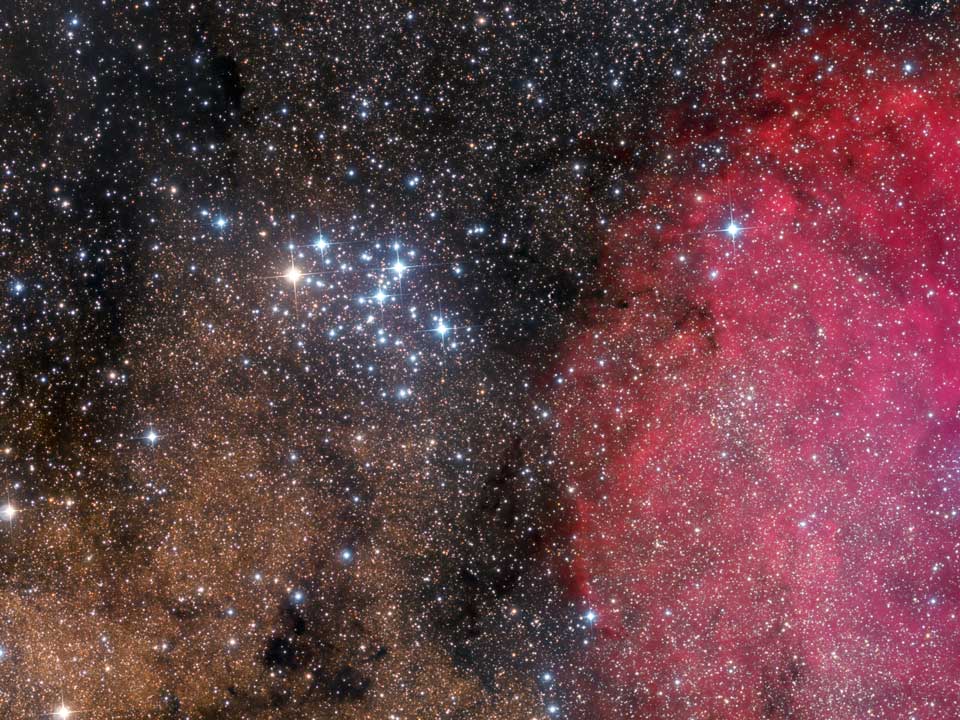 To some, the outline of the open cluster of stars M6 resembles a butterfly. M6, also known as NGC 6405, spans about 20 light-years and lies about 2,000 light years distant. M6, pictured above, can best be seen in a dark sky with binoculars towards the constellation of the Scorpion (Scorpius), coving about as much of the sky as the full moon. Like other open clusters, M6 is composed predominantly of young blue stars, although the brightest star is nearly orange. M6 is estimated to be about 100 million years old. Determining the distance to clusters like M6 helps astronomers calibrate the distance scale of the universe.
__________________
1st in Kommisar's 2009 SM Tournament 1st in I Love You`s 2009 New Year`s Tournament 3rd in EnR's Mashfest '08 tournament 5th in Phynx's Unofficial FFR Tournament 9th in D3 of the 2008-2009 4th Official FFR Tournament 10th in D5 of the 2010 5th Official FFR Tournament 10th in D6 of the 2011-2012 6th Official FFR Tournament FMO AAA Count: 71 FGO AAA Count: 10 Bluearrowll = The Canadian player who can not detect awkward patterns. If it's awkward for most people, it's normal for Terry. If the file is difficult but super straight forward, he has issues. If he's AAAing a FGO but then heard that his favorite Hockey team was losing by a point, Hockey > FFR PS: Cool AAA's Terry - I Love You An Alarm Clock's Haiku beep beep beep beep beep beep beep beep beep beep beep beep beep beep beep beep beep - ieatyourlvllol |
|
|

|
|
|
#1040 |
|
⊙▃⊙
|
Daily Suspicious0bserver's Weather Post:
September 4, 2014 What's in the sky tonight? September 4, 2014 -In Friday's dawn, use binoculars to help pick up Venus just above the eastern horizon about 30 minutes before sunrise. It's far to the lower left of Jupiter. Can you make out Regulus, less than a hundredth as bright, within 1░ of Venus? -On Sept. 2nd, an enormous filament of dark plasma, which had been snaking across the face of the sun for days, became unstable and erupted. NASA's Solar Dynamics Observatory recorded the event (movies: #1, #2). A CME emerging from the blast site appears to have an Earth-directed component. According to NOAA analysts, the CME could deliver a glancing blow to Earth's magnetic field on Sept. 6th. This is not a particularly fast or powerful CME. Nevertheless, the coming impact could spark auroras. The last two minor CMEs that struck Earth in late August triggered beautiful displays of Northern and Southern Lights. The reason: it's aurora season. High-latitude sky watchers should prepare for Sept. 6th. Astro Picture of the Day: September 4, 2014  On October 19th, a good place to watch Comet Siding Spring will be from Mars. Then, this inbound visitor (C/2013 A1) to the inner solar system, discovered in January 2013 by Robert McNaught at Australia's Siding Spring Observatory, will pass within 132,000 kilometers of the Red Planet. That's a near miss, equivalent to just over 1/3 the Earth-Moon distance. Great views of the comet for denizens of planet Earth's southern hemisphere are possible now, though. This telescopic snapshot from August 29 captured the comet's whitish coma and arcing dust tail sweeping through southern skies. The fabulous field of view includes, the Small Magellanic Cloud and globular star clusters 47 Tucanae (right) and NGC 362 (upper left). Worried about all those spacecraft in Martian orbit? Streaking dust particles from the comet could pose a danger and controllers plan to position Mars orbiters on the opposite side of the planet during the comet's close flyby.
__________________
1st in Kommisar's 2009 SM Tournament 1st in I Love You`s 2009 New Year`s Tournament 3rd in EnR's Mashfest '08 tournament 5th in Phynx's Unofficial FFR Tournament 9th in D3 of the 2008-2009 4th Official FFR Tournament 10th in D5 of the 2010 5th Official FFR Tournament 10th in D6 of the 2011-2012 6th Official FFR Tournament FMO AAA Count: 71 FGO AAA Count: 10 Bluearrowll = The Canadian player who can not detect awkward patterns. If it's awkward for most people, it's normal for Terry. If the file is difficult but super straight forward, he has issues. If he's AAAing a FGO but then heard that his favorite Hockey team was losing by a point, Hockey > FFR PS: Cool AAA's Terry - I Love You An Alarm Clock's Haiku beep beep beep beep beep beep beep beep beep beep beep beep beep beep beep beep beep - ieatyourlvllol |
|
|

|
 |
| Currently Active Users Viewing This Thread: 1 (0 members and 1 guests) | |
| Thread Tools | |
| Display Modes | |
|
|